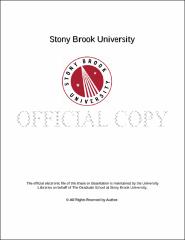| dc.identifier.uri | http://hdl.handle.net/11401/77778 | |
| dc.description.sponsorship | This work is sponsored by the Stony Brook University Graduate School in compliance with the requirements for completion of degree. | en_US |
| dc.format | Monograph | |
| dc.format.medium | Electronic Resource | en_US |
| dc.language.iso | en_US | |
| dc.publisher | The Graduate School, Stony Brook University: Stony Brook, NY. | |
| dc.type | Dissertation | |
| dcterms.abstract | Climate Change is among the most important problems challenging today’s scientific community with far reaching impact for the world at large. Numerous efforts have been directed towards designing state of the art climate models which can simulate a realistic projection of the future climate and provide a true picture of the changing environment in the coming years. Despite decades of effort on the part of the climate modeling community, models still differ greatly in their prognosis of future climate change. However, they are all in agreement that clouds and their radiative feedback are the key players responsible for the divergence in model projections. Therefore, constraining the climate changes in clouds and their radiative forcing in the models could in effect constrain the wide range of climate sensitivity exhibited by them. The present dissertation investigates the possibility of constraining the future cloud changes simulated by the models by using short term climate phenomenon. It was found that in the mid-latitudinal belt, seasonal changes in cloud properties, from cold to warm season, correlated well with their long term changes due to climate warming. Observational estimates of seasonal changes from satellite data were used to assess current model performance and detect possible biases that could translate into their climate projections. In the tropical belt, a different approach was formulated whereby the mean surface temperature in the tropics was used to classify warm and cold years and then the difference in cloud properties between them was computed to represent transition from cold to warm climate. Such a temporal shift in temperature resulted in cloud evolution that correlated reasonably well with their long term climate change counterparts. In the last part of this dissertation, model spread in cloud radiative forcing and possibilities of constraining it with observational data have been analyzed. | |
| dcterms.abstract | Climate Change is among the most important problems challenging today’s scientific community with far reaching impact for the world at large. Numerous efforts have been directed towards designing state of the art climate models which can simulate a realistic projection of the future climate and provide a true picture of the changing environment in the coming years. Despite decades of effort on the part of the climate modeling community, models still differ greatly in their prognosis of future climate change. However, they are all in agreement that clouds and their radiative feedback are the key players responsible for the divergence in model projections. Therefore, constraining the climate changes in clouds and their radiative forcing in the models could in effect constrain the wide range of climate sensitivity exhibited by them. The present dissertation investigates the possibility of constraining the future cloud changes simulated by the models by using short term climate phenomenon. It was found that in the mid-latitudinal belt, seasonal changes in cloud properties, from cold to warm season, correlated well with their long term changes due to climate warming. Observational estimates of seasonal changes from satellite data were used to assess current model performance and detect possible biases that could translate into their climate projections. In the tropical belt, a different approach was formulated whereby the mean surface temperature in the tropics was used to classify warm and cold years and then the difference in cloud properties between them was computed to represent transition from cold to warm climate. Such a temporal shift in temperature resulted in cloud evolution that correlated reasonably well with their long term climate change counterparts. In the last part of this dissertation, model spread in cloud radiative forcing and possibilities of constraining it with observational data have been analyzed. | |
| dcterms.available | 2017-09-20T16:53:34Z | |
| dcterms.contributor | Khairoutdinov, Marat | en_US |
| dcterms.contributor | Zhang, Minghua | en_US |
| dcterms.contributor | Hameed, Sultan | en_US |
| dcterms.contributor | Lin, Wuyin | en_US |
| dcterms.contributor | Xie, Shaocheng. | en_US |
| dcterms.creator | Mukherjee, Parama | |
| dcterms.dateAccepted | 2017-09-20T16:53:34Z | |
| dcterms.dateSubmitted | 2017-09-20T16:53:34Z | |
| dcterms.description | Department of Marine and Atmospheric Science. | en_US |
| dcterms.extent | 143 pg. | en_US |
| dcterms.format | Application/PDF | en_US |
| dcterms.format | Monograph | |
| dcterms.identifier | http://hdl.handle.net/11401/77778 | |
| dcterms.issued | 2015-05-01 | |
| dcterms.language | en_US | |
| dcterms.provenance | Made available in DSpace on 2017-09-20T16:53:34Z (GMT). No. of bitstreams: 1
Mukherjee_grad.sunysb_0771E_12621.pdf: 3399051 bytes, checksum: 9fef9ce6a644f8bc86bd0a1c9c0a8b08 (MD5)
Previous issue date: 2015 | en |
| dcterms.publisher | The Graduate School, Stony Brook University: Stony Brook, NY. | |
| dcterms.subject | Atmospheric sciences | |
| dcterms.title | Constraining Climate Model projections of Change in Clouds and their Radiative Feedback | |
| dcterms.type | Dissertation | |

